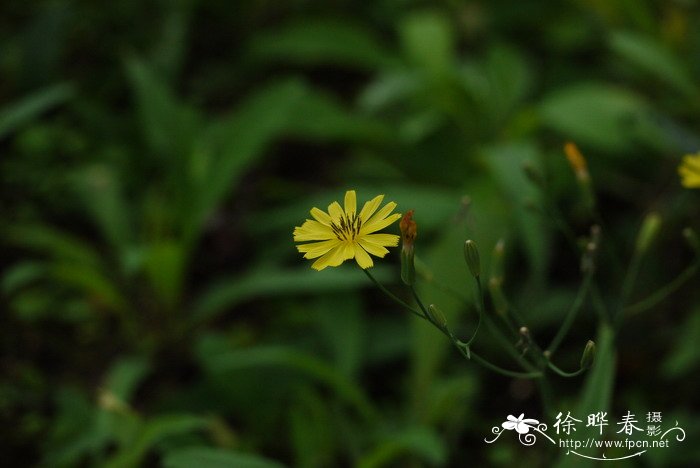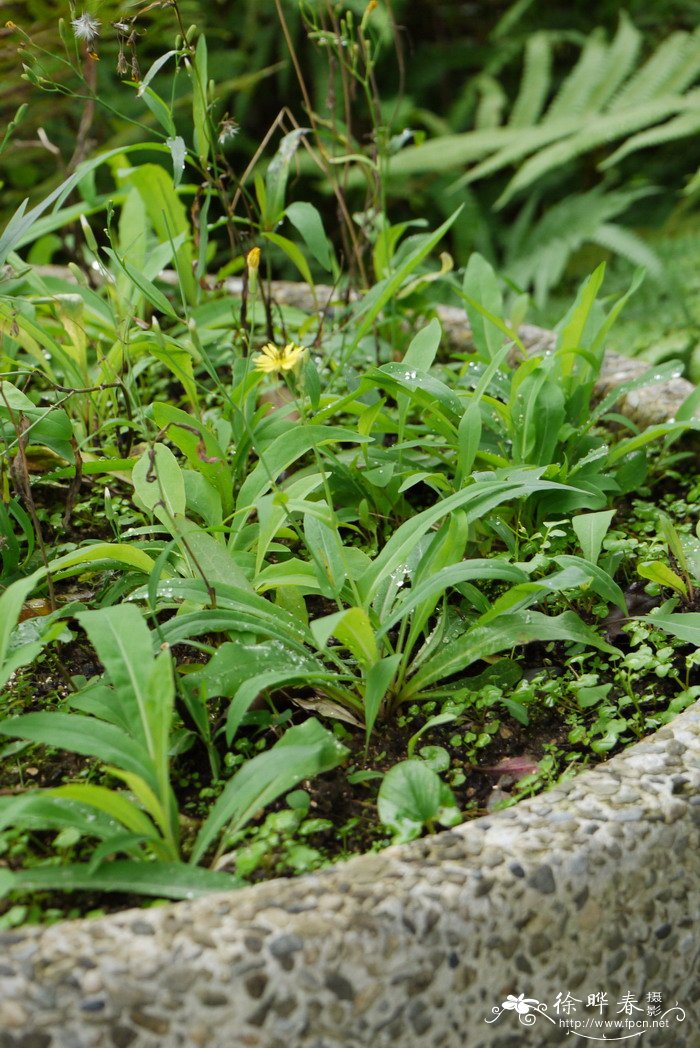中华苦荬菜Ixeris chinensis
中文名(Chinese Name):中华苦荬菜
学名(Scientific Name):Ixeris chinensis (Thunb. ex Thunb.) Nakai
英文名(English Common Name):
别名(Chinese Common Name):小苦苣,黄鼠草,山苦荬
异名(Synonym):Ixeridium chinense (Thunb.) Tzvel. Ixeris chinensis var. saxatilis (Kitam.) Kitam. Lactuca flavissima Hayata Lactuca lacerrima f. flavissima (Hayata) Kitam. Lactuca lacerrima Hayata Lactuca rubrolutea Vaniot Prenanthes chinensis Thunb. Youngia chinensis (Thunb.) DC. Chondrilla chinensis (Thunb.) Poir. Paraixeris chinensis (Thunb.) H.S.Pak Ixeris chinensis f. lacerrima (Hay.) Yamam. Ixeris chinensis f. taitoensis (Hayata) Yamam. Ixeris lacerrima (Hayata) Kitag. Lactuca taitoensis Hayata Lactuca lacerrima var. saxatilis Kitam. Prenanthes chinensis:thunb Ixeris chinensis subsp. chinensis
科属(Family & Genus):菊科Compositae苦荬菜属Ixeris
形态特征(Description):多年生草本,高5-47厘米。根垂直直伸,通常不分枝。根状茎极短缩。茎直立单生或少数茎成簇生,基部直径1-3毫米,上部伞房花序状分枝。基生叶长椭圆形、倒披针形、线形或舌形,包括叶柄长2.5-15厘米,宽2-5.5厘米,顶端钝或急尖或向上渐窄,基部渐狭成有翼的短或长柄,全缘,不分裂亦无锯齿或边缘有尖齿或凹齿,或羽状浅裂、半裂或深裂,侧裂片2-7对,长三角形、线状三角形或线形,自中部向上或向下的侧裂片渐小,向基部的侧裂片常为锯齿状,有时为半圆形。茎生叶2-4枚,极少1枚或无茎叶,长披针形或长椭圆状披针形,不裂,边缘全缘,顶端渐狭,基部扩大,耳状抱茎或至少基部茎生叶的基部有明显的耳状抱茎;全部叶两面无毛。头状花序通常在茎枝顶端排成伞房花序,含舌状小花21-25枚。总苞圆柱状,长8-9毫米;总苞片3-4层,外层及最外层宽卵形,长1.5毫米,宽0.8毫米,顶端急尖,内层长椭圆状倒披针形,长8-9毫米,宽1-1.5毫米,顶端急尖。舌状小花黄色,干时带红色。瘦果褐色,长椭圆形,长2. 2毫米,宽0.3毫米,有10条高起的钝肋,肋上有上指的小刺毛,顶端急尖成细喙,喙细,细丝状,长2.8毫米。冠毛白色,微糙,长5毫米。花果期1-10月。
分布(Distribution):分布黑龙江、河北、山西、陕西、山东、江苏、安徽、浙江、江西、福建、台湾、河南、四川、贵州、云南、西藏。生于山坡路旁、田野、河边灌丛或岩石缝隙中。俄罗斯远东地区及西伯利亚、日本、朝鲜有分布。
用途(Use):
引自中国植物志英文版:FOC Vol. 20-21 Page 331, 332, 333
FOC | Family List | FOC Vol. 20-21
5. Ixeris chinensis (Thunberg) Kitagawa, Bot. Mag. (Tokyo). 48: 113. 1934.
中华苦荬菜 zhong hua ku mai cai | Asteraceae | Ixeris
Herbs 5-50 cm tall, perennial, rosulate, glabrous. Taproot, often with shoot-bearing lateral roots. Stems usually few to several, rarely solitary, ascending-erect to erect, branched from base or higher up. Rosette leaves oblanceolate, elliptic, narrowly elliptic, or ± linear, 6-24 × 1-2 cm, undivided or pinnatifid to pinnatipartite, basally attenuate, margin entire or sinuate-dentate, apex obtuse, acute, or attenuate; lateral lobes 2-7 pairs, narrowly triangular, linear-triangular, or linear. Stem leaves (0 or)1-4, narrowly lanceolate to linear-lanceolate, mostly undivided or more rarely pinnatifid, base semiamplexicaul and usually not or rarely with a basal pair of sideward directed clasping lobes, margin entire, apex acuminate. Synflorescence laxly corymbiform, with few to many capitula. Capitula with 15-25 florets; peduncle wiry, ca. 1 to several cm. Involucre cylindric, 6-11 mm. Phyllaries abaxially glabrous, apex acute; outer phyllaries ± ovate, longest 1-1.5 mm; inner phyllaries 8. Florets bright yellow, pale yellow, white, or purplish. Anther tube and style greenish to blackish upon drying. Achene brown, subfusiform, 4-6 mm, apex attenuate into a slender 2.5-3 mm beak. Pappus ca. 5 mm. Fl. and fr. Jun-Oct.
Grasslands on mountain slopes, forests, forest margins, along rivers, ravines, open areas, degraded shrublands, thickets, riverbanks, rock crevices, sandy soil areas, fields, field margins, wastelands, roadsides; below 100-4000 m. Anhui, Chongqing, Fujian, Gansu, Guangdong, Guangxi, Guizhou, Hainan, Hebei, Heilongjiang, Henan, Hubei, Hunan, Jiangsu, Jiangxi, Jilin, Liaoning, Nei Mongol, Ningxia, Qinghai, Shaanxi, Shandong, Shanxi, Sichuan, Taiwan, Xinjiang, Xizang, Yunnan, Zhejiang [?Cambodia, Japan, Korea, Laos, Mongolia, E Russia, ?Thailand, Vietnam].
Ixeris chinensis includes diploid, triploid, and tetraploid cytotypes. Pak et al. (Acta Phytotax. Geobot. 48: 187-196. 1997) have shown that all three cytotype are present in mainland Asia, while in Taiwan only the diploid cytotype and in Japan only the triploid and tetraploid cytotypes occur. Otherwise, all three cytotypes frequently seem to occur sympatrically. The triploid and tetraploid cytotypes have been identified with I. chinensis subsp. strigosa (see Kitamura, Mem. Coll. Sci. Kyoto Imp. Univ., Ser. B, Biol. 23: 112-116. 1956), which has long involucres (9-10 mm) and achenes as well as whitish or pale purplish florets. The diploid cytotype has been identified with I. chinensis subsp. chinensis, which has involucres of 6-8 mm and yellow florets. The third subspecies recognized by Kitamura, I. chinensis subsp. versicolor (sometimes even treated as two separate species, I. graminea and I. graminifolia, see, e.g., under Ixeridium, in Tzvelev, Fl. URSS 29: 388-392. 1964; Rast. Tsentral. Azii 14b: 62-65. 2008) appears rather to include forms intermediate between the former two at least with respect to involucre length (8-9 mm) and floret color (variably yellow, white, or purplish). It was not included in the analysis by Pak et al. (loc. cit.) and is little understood, even with respect to its actual delimitation from I. chinensis subsp. strigosa. Until further studies, such as started by Pak et al. (loc. cit.), are available that also include I. chinensis subsp. versicolor, the taxonomy of I. chinensis remains unsatisfactory. For the time being, it appears appropriate basically to maintain the classification of Kitamura (loc. cit. 1956) with three subspecies, the delimitation between them, however, not being clear-cut, and especially between I. chinensis subsp. versicolor and I. chinensis subsp. strigosa often questionable in material from China. The distribution ranges given below should therefore be taken with great caution. Leaf shape is very variable in I. chinensis; this variation, however, follows patterns not unusual in the genus and the tribe and is taxonomically of no value.


(责任编辑:徐晔春)
学名(Scientific Name):Ixeris chinensis (Thunb. ex Thunb.) Nakai
英文名(English Common Name):
别名(Chinese Common Name):小苦苣,黄鼠草,山苦荬
异名(Synonym):Ixeridium chinense (Thunb.) Tzvel. Ixeris chinensis var. saxatilis (Kitam.) Kitam. Lactuca flavissima Hayata Lactuca lacerrima f. flavissima (Hayata) Kitam. Lactuca lacerrima Hayata Lactuca rubrolutea Vaniot Prenanthes chinensis Thunb. Youngia chinensis (Thunb.) DC. Chondrilla chinensis (Thunb.) Poir. Paraixeris chinensis (Thunb.) H.S.Pak Ixeris chinensis f. lacerrima (Hay.) Yamam. Ixeris chinensis f. taitoensis (Hayata) Yamam. Ixeris lacerrima (Hayata) Kitag. Lactuca taitoensis Hayata Lactuca lacerrima var. saxatilis Kitam. Prenanthes chinensis:thunb Ixeris chinensis subsp. chinensis
科属(Family & Genus):菊科Compositae苦荬菜属Ixeris
形态特征(Description):多年生草本,高5-47厘米。根垂直直伸,通常不分枝。根状茎极短缩。茎直立单生或少数茎成簇生,基部直径1-3毫米,上部伞房花序状分枝。基生叶长椭圆形、倒披针形、线形或舌形,包括叶柄长2.5-15厘米,宽2-5.5厘米,顶端钝或急尖或向上渐窄,基部渐狭成有翼的短或长柄,全缘,不分裂亦无锯齿或边缘有尖齿或凹齿,或羽状浅裂、半裂或深裂,侧裂片2-7对,长三角形、线状三角形或线形,自中部向上或向下的侧裂片渐小,向基部的侧裂片常为锯齿状,有时为半圆形。茎生叶2-4枚,极少1枚或无茎叶,长披针形或长椭圆状披针形,不裂,边缘全缘,顶端渐狭,基部扩大,耳状抱茎或至少基部茎生叶的基部有明显的耳状抱茎;全部叶两面无毛。头状花序通常在茎枝顶端排成伞房花序,含舌状小花21-25枚。总苞圆柱状,长8-9毫米;总苞片3-4层,外层及最外层宽卵形,长1.5毫米,宽0.8毫米,顶端急尖,内层长椭圆状倒披针形,长8-9毫米,宽1-1.5毫米,顶端急尖。舌状小花黄色,干时带红色。瘦果褐色,长椭圆形,长2. 2毫米,宽0.3毫米,有10条高起的钝肋,肋上有上指的小刺毛,顶端急尖成细喙,喙细,细丝状,长2.8毫米。冠毛白色,微糙,长5毫米。花果期1-10月。
分布(Distribution):分布黑龙江、河北、山西、陕西、山东、江苏、安徽、浙江、江西、福建、台湾、河南、四川、贵州、云南、西藏。生于山坡路旁、田野、河边灌丛或岩石缝隙中。俄罗斯远东地区及西伯利亚、日本、朝鲜有分布。
用途(Use):
引自中国植物志英文版:FOC Vol. 20-21 Page 331, 332, 333
FOC | Family List | FOC Vol. 20-21
5. Ixeris chinensis (Thunberg) Kitagawa, Bot. Mag. (Tokyo). 48: 113. 1934.
中华苦荬菜 zhong hua ku mai cai | Asteraceae | Ixeris
Herbs 5-50 cm tall, perennial, rosulate, glabrous. Taproot, often with shoot-bearing lateral roots. Stems usually few to several, rarely solitary, ascending-erect to erect, branched from base or higher up. Rosette leaves oblanceolate, elliptic, narrowly elliptic, or ± linear, 6-24 × 1-2 cm, undivided or pinnatifid to pinnatipartite, basally attenuate, margin entire or sinuate-dentate, apex obtuse, acute, or attenuate; lateral lobes 2-7 pairs, narrowly triangular, linear-triangular, or linear. Stem leaves (0 or)1-4, narrowly lanceolate to linear-lanceolate, mostly undivided or more rarely pinnatifid, base semiamplexicaul and usually not or rarely with a basal pair of sideward directed clasping lobes, margin entire, apex acuminate. Synflorescence laxly corymbiform, with few to many capitula. Capitula with 15-25 florets; peduncle wiry, ca. 1 to several cm. Involucre cylindric, 6-11 mm. Phyllaries abaxially glabrous, apex acute; outer phyllaries ± ovate, longest 1-1.5 mm; inner phyllaries 8. Florets bright yellow, pale yellow, white, or purplish. Anther tube and style greenish to blackish upon drying. Achene brown, subfusiform, 4-6 mm, apex attenuate into a slender 2.5-3 mm beak. Pappus ca. 5 mm. Fl. and fr. Jun-Oct.
Grasslands on mountain slopes, forests, forest margins, along rivers, ravines, open areas, degraded shrublands, thickets, riverbanks, rock crevices, sandy soil areas, fields, field margins, wastelands, roadsides; below 100-4000 m. Anhui, Chongqing, Fujian, Gansu, Guangdong, Guangxi, Guizhou, Hainan, Hebei, Heilongjiang, Henan, Hubei, Hunan, Jiangsu, Jiangxi, Jilin, Liaoning, Nei Mongol, Ningxia, Qinghai, Shaanxi, Shandong, Shanxi, Sichuan, Taiwan, Xinjiang, Xizang, Yunnan, Zhejiang [?Cambodia, Japan, Korea, Laos, Mongolia, E Russia, ?Thailand, Vietnam].
Ixeris chinensis includes diploid, triploid, and tetraploid cytotypes. Pak et al. (Acta Phytotax. Geobot. 48: 187-196. 1997) have shown that all three cytotype are present in mainland Asia, while in Taiwan only the diploid cytotype and in Japan only the triploid and tetraploid cytotypes occur. Otherwise, all three cytotypes frequently seem to occur sympatrically. The triploid and tetraploid cytotypes have been identified with I. chinensis subsp. strigosa (see Kitamura, Mem. Coll. Sci. Kyoto Imp. Univ., Ser. B, Biol. 23: 112-116. 1956), which has long involucres (9-10 mm) and achenes as well as whitish or pale purplish florets. The diploid cytotype has been identified with I. chinensis subsp. chinensis, which has involucres of 6-8 mm and yellow florets. The third subspecies recognized by Kitamura, I. chinensis subsp. versicolor (sometimes even treated as two separate species, I. graminea and I. graminifolia, see, e.g., under Ixeridium, in Tzvelev, Fl. URSS 29: 388-392. 1964; Rast. Tsentral. Azii 14b: 62-65. 2008) appears rather to include forms intermediate between the former two at least with respect to involucre length (8-9 mm) and floret color (variably yellow, white, or purplish). It was not included in the analysis by Pak et al. (loc. cit.) and is little understood, even with respect to its actual delimitation from I. chinensis subsp. strigosa. Until further studies, such as started by Pak et al. (loc. cit.), are available that also include I. chinensis subsp. versicolor, the taxonomy of I. chinensis remains unsatisfactory. For the time being, it appears appropriate basically to maintain the classification of Kitamura (loc. cit. 1956) with three subspecies, the delimitation between them, however, not being clear-cut, and especially between I. chinensis subsp. versicolor and I. chinensis subsp. strigosa often questionable in material from China. The distribution ranges given below should therefore be taken with great caution. Leaf shape is very variable in I. chinensis; this variation, however, follows patterns not unusual in the genus and the tribe and is taxonomically of no value.
(责任编辑:徐晔春)
踩一下[4]

顶一下[11]